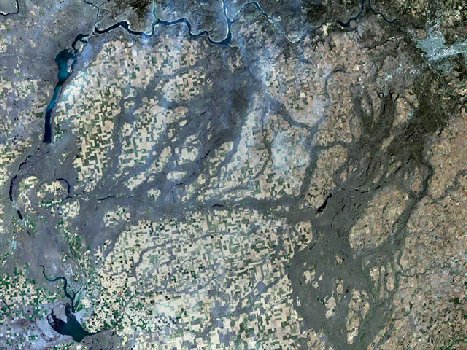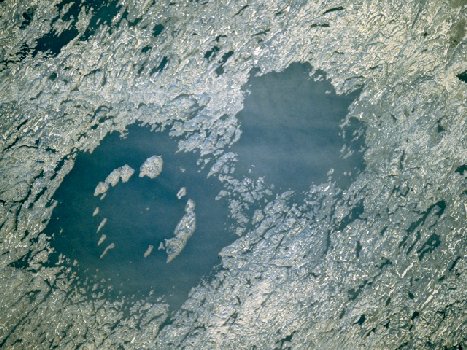| Global Catastrophes |
| Most natural hazards affect only the area local to the event. There are some events, however, which can change an entire continent or even the whole world.
Several religions tell the story of a huge flood early in the history of mankind. In eastern Washington state, there is evidence of rapid and extensive flooding dating from the end of the last ice age, 15,500-13,000 years ago. The Channelled Scablands are areas where great thicknesses of topsoil have been removed, exposing the underlying lava beds of the Columbia Plateau. These steep-sided canyons were scoured out by the water of a huge lake which was held back by a glacier acting as an ice dam. When the glacier started to melt, the water was released very quickly and surged out across the plateau and on down the Columbia River Valley to the Pacific Ocean.
The Channeled Scablands of the northwest USA, appearing dark between the field patterns of agricultural land.
The rising waters of the Mediterranean surged through the Bosporus (bottom of picture) at the end of the last ice age, dramatically expanding the area of the Black Sea to the north. Other sites of large ice-dammed lakes and large-scale flooding have been found in North America and Asia. The melting icecaps also raised global sea levels by as much as 100 metres (300 feet). It is probable that the origin of the great flood in the Bible is one or several coastal events around the Middle East at this time. Perhaps the most catastrophic would have been the flooding of the Black Sea depression as the rising waters of the Mediterranean burst through the Bosporus. Volcanic eruptions release ash and gases into the atmosphere which can alter climate patterns. Volcanoes produce sulphur dioxide particles which reflect sunlight back out into space, leading to a cooling of the atmosphere. Violent eruptions in Iceland in 1783 led to a decade of unseasonably cold summers, crop failures, hunger and social unrest in Europe. 20 million tons of sulphur dioxide were pumped into the atmosphere by Mt Pinatubo in 1990, lowering the global average temperature by 0.3-0.5 degrees Celsius.
Satellite instruments tracked the distribution of sulphur dioxide around the world after the eruption of Mt Pinatubo in 1990. Many volcanoes in the interior of continents are known to sit above "hot spots" or plumes in the Earth's mantle. While most plumes rise from the base of the upper mantle, 670km (418 miles)deep, plumes that rise from the core-mantle boundary, 2900km (1812 miles) deep, are capable of releasing huge amounts of energy and material, which dwarf even the largest eruptions on historic record. Lava plateau thousands of kilometres across and up to 40km (25 miles)thick are thought to have resulted from superplumes reaching the Earth's surface at several dates in the geological record. Such eruptions would release huge amounts of the greenhouse gas, carbon dioxide, and some coincide with times known to have a warmer global climate. The flood basalts of the Deccan Traps in India erupted 65 million years ago, around about the time of the last great mass extinction, which killed the dinosaurs. The hotspot underlying the Yellowstone caldera in the western USA is thought to be a dormant superplume. If it resumed its past activity, it could cover 30,000 sq. km (18,750 sq miles)with volcanic ash and disrupt climate and agriculture worldwide. There have been about ten eruptions of this size worldwide in the last million years.
The Deccan Traps lava plateau lies inland of the Western Ghatts mountain range in India.
The hot springs and geysers of Yellowstone National Park lie over the site of a deep mantle plume. The chances of being killed by an asteroid impact are surprisingly high: about the same as dying in a plane crash if you take one return flight a year. Although large asteroid impacts occur very infrequently, their consequences are very far-reaching, with large impacts capable of throwing enough debris into the atmosphere to alter the global climate very quickly. Asteroids are large pieces of rock, most of which orbit the sun between Mars and Jupiter. Some asteroids, however, are found outside this region, with some crossing the orbit of the Earth - the near-Earth asteroids.
Clearwater Lake, Quebec, the highly-eroded remnant of twin asteroid impacts 290 million years ago.
Asteroid 433 Eros, the second-largest near-Earth asteroid, approximately 33km long by 13km wide. Objects less than 50 metres (136 feet). across burn up in the Earth's atmosphere. A slightly larger object might explode in the atmosphere and damage the surface with its shockwave, as happened at Tunguska, Siberia in 1908. While an object 100 metres (273 feet) across might strike the Earth's surface every 1,000 years, a 1km (1056 yard) object hits only every 200,000 years. Such an impact would create a crater 10km (6.25 miles) wide and many millions might die in the impact or from tsunamis if it hit the ocean. One quarter of the human population might die if a body several kilometres across where to hit the Earth, but this only happens every 300,000 years or so. Asteroid impacts could have triggered some of the Earth's mass extinction events, when many species of animal life have abruptly died out, unable to adapt to a very rapid environmental change. |






